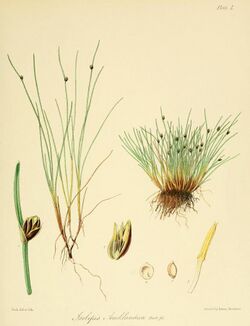Biology:Isolepis aucklandica
| Isolepis aucklandica | |
|---|---|

| |
| Plate L[1] | |
| Scientific classification | |
| Kingdom: | Plantae |
| Clade: | Tracheophytes |
| Clade: | Angiosperms |
| Clade: | Monocots |
| Clade: | Commelinids |
| Order: | Poales |
| Family: | Cyperaceae |
| Genus: | Isolepis |
| Species: | I. aucklandica
|
| Binomial name | |
| Isolepis aucklandica | |
| Synonyms[2] | |
|
Isolepis subcucullata Berggr. | |
Isolepis aucklandica is a species of flowering plant in the Cyperaceae family. It is native to New Zealand, Australia , Argentina , Peru, Colombia, Ecuador, Macquarie Island, the French Southern Territories of Saint Paul and Amsterdam Islands, and New Guinea.[2]
Description
It is a creeping, bright green, leafy, rhizomatous sedge which forms large patches of turf. The culms (10.0–80.0 by about 0.5 mm) are a bright green above, but red-brown towards the base. There are up to 6 leaves per culm, and the leaves are usually longer than the culms. The sheaths are often streaked with red, and sometimes entirely a dark red-purple. The inflorescence consists 1–2 narrow-oblong spikelets (1.0–4.0 by 0.5–2 mm) which are partly hidden by the base of the subtending bract which is up to 5 times length of spikelet. There are three stamens and three style-branches . The shining nut is 1–2 mm long by about 0.5 mm wide, triangular in cross-section with rounded angles, almost white to yellowish, or grey- to red-brown, and it tapers towards its black tip.[4]
It flowers from October to December and fruits from November to May.[4]
Habitat
It is found on the coast and up to 1300 m altitude, in boggy ground in forests and wetlands and seepages.[4]
Distribution
Within Australia, it is found in Tasmania, Victoria and New South Wales.[2]
Conservation status
This species was classified as "Not Threatened" in 2012 under the New Zealand Threat Classification System.,[4] and again in 2018.[5]
References
- ↑ Hooker, J.D. (1852) Bot. Antarct. Voy. I. (Fl. Antarct.). 1. 1844. p. Plate 50. https://biodiversitylibrary.org/page/13448478.
- ↑ 2.0 2.1 2.2 2.3 "Isolepis aucklandica Hook.f. | Plants of the World Online | Kew Science". http://powo.science.kew.org/taxon/urn:lsid:ipni.org:names:309206-1.
- ↑ Hooker, J.D. (1844) Bot. Antarct. Voy. I. (Fl. Antarct.). 1. 1844. p. 88, t. 50. https://biodiversitylibrary.org/page/3011426.
- ↑ 4.0 4.1 4.2 4.3 "Isolepis aucklandica | New Zealand Plant Conservation Network". http://nzpcn.org.nz/flora_details.aspx?ID=2165.
- ↑ Lange, Peter J. de; Rolfe, Jeremy R.; Barkla, John W.; Courtney, Shannel P.; Champion, Paul D.; Perrie, Leon R.; Beadel, Sarah M.; Ford, Kerry A. et al. (2018-05-01). "Conservation status of New Zealand indigenous vascular plants, 2017". New Zealand Threat Classification Series 22: 67. OCLC 1041649797. https://www.doc.govt.nz/globalassets/documents/science-and-technical/nztcs22entire.pdf.
External links
- Isolepis aucklandica occurrence data from Australasian Virtual Herbarium
- Isolepis aucklandica occurrence data from GBIF]
Wikidata ☰ Q15586185 entry
 |

